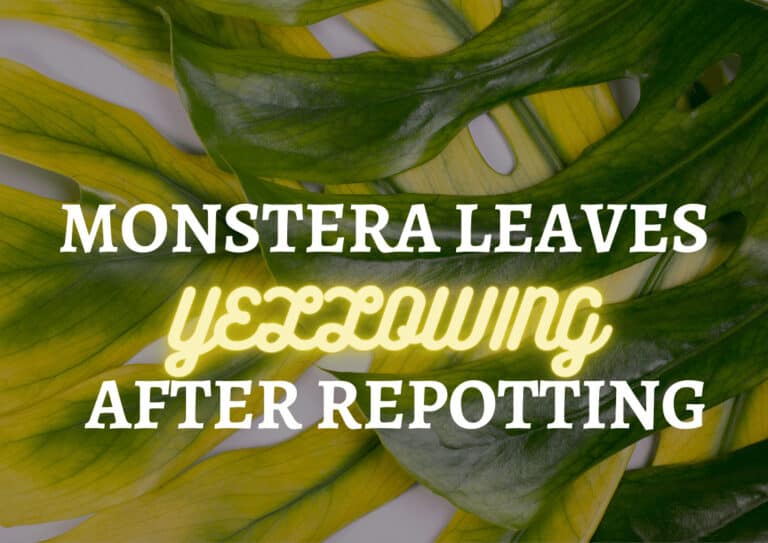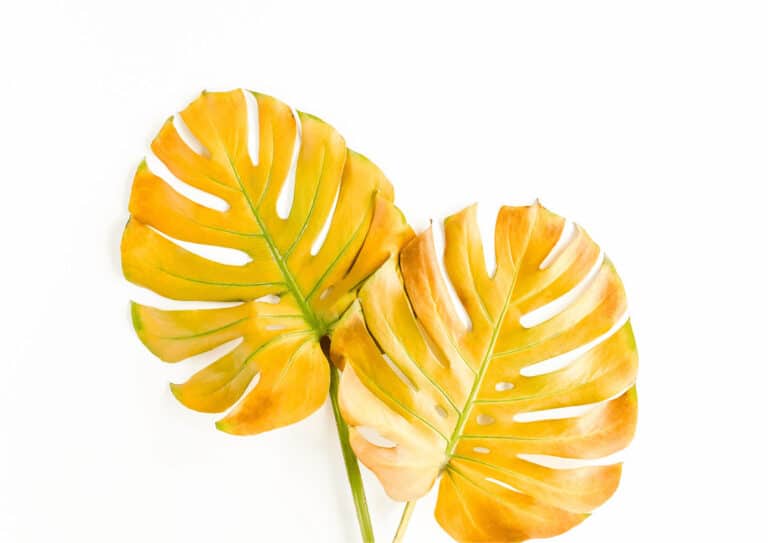Monstera Leaves Yellowing After Repotting: Causes and Solutions
-
Chris Dosser
- May 12, 2023
If you buy something using the retail links in our articles, sometimes we earn a small affiliate commission. This does not impact the products we recommend.
Yellowing leaves may be a sign that your monstera is experiencing shock or stress due to being re-potted process, or a drastic change in environmental conditions or moisture levels in the soil.
While this yellowing is typically temporary, it is crucial to understand the possible causes and remedies for ensuring the long-term health of your monstera plant. Factors such as overwatering, underwatering, and nutrient deficiencies can contribute to the issue, making it essential to closely monitor your plant during the repotting process and afterward.
Causes of Yellowing Monstera Leaves
Overwatering
One common cause of yellowing leaves in Monstera plants after repotting is overwatering. When the plant receives too much water, the lower leaves may begin to turn yellow, a sign that the roots are not getting enough oxygen, eventually leading to root rot.

Underwatering
Underwatering can also lead to yellowing leaves, as the plant struggles to receive the proper hydration it needs for growth. This can cause an imbalance in nutrients and stress the plant, resulting in discolored leaves.
Improper Soil Mix
A yellowing Monstera might be struggling with an incorrect soil mix. Monstera plants require a well-draining mix that retains moisture without becoming waterlogged. An improper soil can cause drainage issues or prevent the plant from accessing essential nutrients, leading to yellowing leaves.
Root Damage
Root damage is another potential cause of yellow leaves. During the repotting process, roots can be accidentally damaged or cut, causing stress to the plant and affecting its ability to absorb nutrients and water. This can manifest as yellow leaves as the plant struggles to recover.
Stress from Repotting
Lastly, stress from repotting can cause yellowing leaves in Monstera plants, as they adapt to their new environment. Transplant shock, which includes wilting and yellowing leaves, can occur due to the disturbance and new conditions the plant faces. As the plant adjusts to its new pot and soil, it may initially show signs of stress through yellowing leaves.
How to Prevent Monstera Leaves from Yellowing After Repotting
Choosing the Right Pot and Soil
When repotting your monstera plant, it’s crucial to select the correct pot size and well-draining soil. Avoid using a pot that is significantly larger than the previous one, as larger pots can retain excessive moisture and lead to yellowing leaves.
A pot with drainage holes is also essential to prevent waterlogging. For the soil, opt for a high-quality, well-draining mix rich in organic matter, such as a blend of peat moss, perlite, and compost.
Proper Watering Techniques
Improper watering is a common cause of yellowing monstera leaves. To prevent this issue, wait until the top 1-2 inches of soil feel dry to the touch before watering. Water the plant thoroughly, allowing excess water to drain out of the pot. Keep in mind that the plant’s water requirements may change after repotting, so monitor the soil moisture closely during the first few weeks.
Repotting at the Appropriate Time
Choosing the right time to repot your monstera is important for avoiding stress and yellowing leaves. The optimal time for repotting is during the plant’s active growing season, typically in spring or early summer. This allows the monstera to quickly adjust to its new pot and soil conditions, reducing the chances of yellowing leaves.

How to Revive a Monstera with Yellowing Leaves
Trimming Damaged Leaves
Begin the revival process by trimming any damaged or severely yellow leaves. Use sanitized scissors to remove these leaves from the base, taking care not to damage the surrounding healthy foliage. This will help redirect the plant’s energy towards new growth and recovery.
Adjusting Watering Schedule
In most cases, yellowing leaves can be attributed to overwatering or insufficient drainage after repotting. To address this, adjust your watering schedule by allowing the top layer of soil to dry before watering again. Alternatively, incorporate the use of a moisture meter to check the soil moisture levels, ensuring that the roots do not sit in stagnate water. Monsteras thrive in slightly moist but well-draining soil.
Reevaluating Soil and Pot
Reevaluate the soil type and pot size, as these factors can impact the health of your Monstera. Ensure that the soil mix provides proper aeration, moisture retention, and pH balance for optimal growth. Additionally, consider repotting the plant in a larger pot if its root system has outgrown its current space, taking care to make the transition smooth and gentle.
Monitoring Recovery
After making the necessary adjustments, monitor your Monstera’s recovery. Look for healthy new growth, such as fresh leaves, and reduced yellowing of existing foliage. Be patient, as recovering from repotting stress may take several weeks. Don’t be alarmed if some older leaves continue to yellow; the plant is likely shedding them to prioritize new growth. Home for the Harvest explains that the stress of repotting might cause yellowing for a couple of weeks, but the plant should eventually adjust and recover from shock.
Our Favorite Monstera Plants And Supplies On Etsy
Round up…
Repotting stress can be a cause of yellowing monstera leaves, as the plant adjusts to its new environment and potting medium. However, it is usually a temporary issue that resolves itself once the plant acclimates to its new conditions.
To minimize the chances of yellow leaves after repotting, follow these guidelines:
- Choose the appropriate pot size and well-draining potting mix suitable for monsteras.
- Gradually introduce your monstera to its new post-repotting environment, such as light and humidity changes.
- Monitor water requirements, as they may change after repotting.
- Keep an eye on temperature, making sure the plant is not exposed to sudden fluctuations in temperature.
In cases where yellow leaves persist, it is important to consider other potential factors contributing to the issue like overwatering, inadequate lighting, or nutrient deficiencies.

Chris Dosser
Co-Founder of Eden Indoors
Chris is a self-taught horticulturist with over a decade of experience caring for houseplants and creating lush, thriving indoor oases. He specializes in Monstera, and by self admission has a serious problem with buying and propagating rare indoor plants!
Similar Posts
Monstera Siltepecana vs Monstera Peru: How Do They Differ?
Monstera siltepecana and Monstera peru are sometimes confused despite being very different plants. Here's how to ID each & meet their unique needs.
Can You Propagate Monstera From A Leaf Alone?
Is it possible to propagate an entire new Monstera plant from the leaf of an adult plant? Or does the cutting need to include another part of the plant to be successful?



